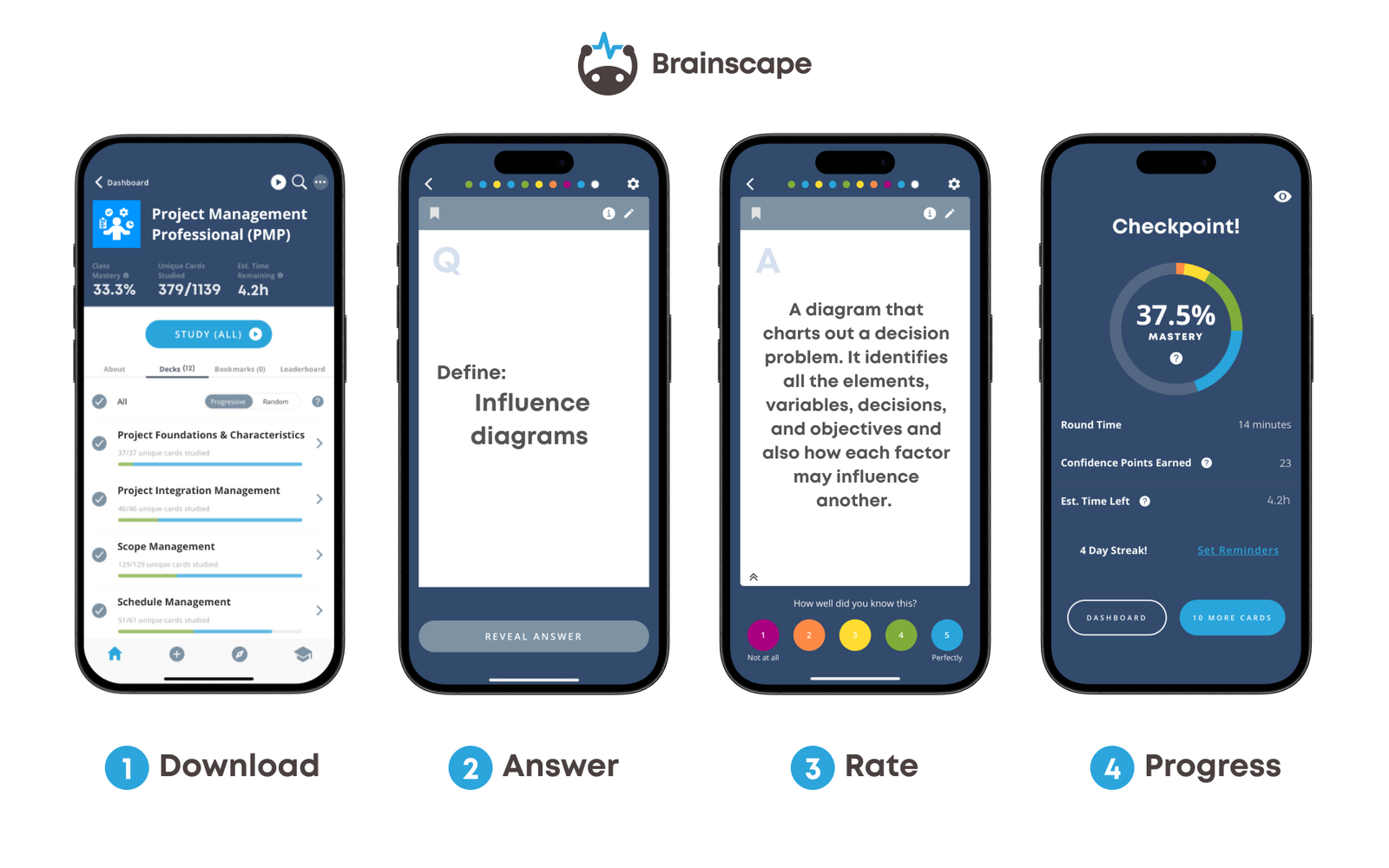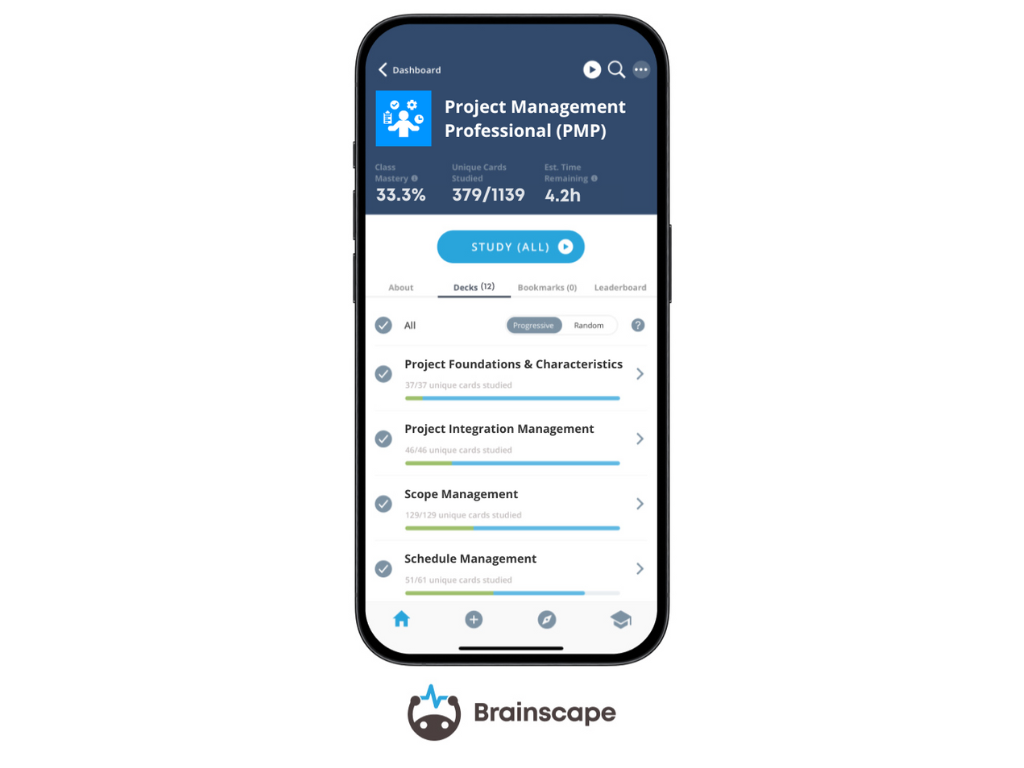Exam day is finally here. And since you’re probably already stressed, the last thing you want is to get tripped up by something as simple as forgetting your ID or getting lost on the way to the venue.
This guide will walk you through exactly what to bring to the PMP exam, how to prepare for breaks, and what small things can make a big difference to your focus, comfort, and performance. Consider this your Project Professionals' packing list (minus the spreadsheets).
Your Study Partner in PMP Prep: Brainscape + Instructing.com
Before we get into your testing session packing list, let us quickly introduce ourselves: We're Brainscape, the creators of a smart, adaptive flashcard app built on the science of spaced repetition. We’ve teamed up with Instructing.com—one of the top names in PMP prep—to build a comprehensive and fully aligned PMP flashcard collection that helps you master every concept on the exam.

Every flashcard is crafted to help Project Professionals retain and apply what matters most, so you walk into the exam with confidence and walk out with three new letters after your name.
Now that you know who we are and why we know a thing or two about the demands of the PMP exam, let's get into what you should bring to the PMP exam...
What Types of Identification Must I Bring to the PMP Exam?
To sit for the Project Management Exam, you’ll need to bring unexpired, government-issued identification. Passports, driver’s licenses, military IDs, or national ID cards are all acceptable identifications (It might be a good idea to bring a secondary identification document just in case.) As long as they include your photo, signature, and full name, which should match the name on your exam registration.
Expired ID? No exam, sorry. It’s that simple. Double-check the expiration date before exam day, and maybe triple-check it if you're the anxious type. If your ID doesn’t meet PMI’s requirements, you won’t be allowed to take the test, which means you’ll forfeit your exam fee.
What Should You Wear on PMP Exam Day?
Comfortable clothes are essential. Think layers, especially if your testing center has unpredictable air conditioning. A hoodie you can slip off, or a scarf that doubles as a comfort object? Approved.
Avoid clothes and accessories that rustle, squeak, jangle, or make noise when you move. (Be considerate of your fellow test takers!) Keep your attire cozy, non-distracting, and test-day ready. It’s not a job interview, so there's no need to get all dolled up.
If you really want to simulate actual test conditions, complete a practice exam in the outfit you intend to wear. You never know whether a rustling jacket or an overly tight cardigan cramps your style until you have to sit through an entire exam wearing it.
What Should You Bring to the PMP Exam Center?
No need to bring your own tools or calculators. You’ll just have to check them into a locker anyway. At in-person testing centers, you’ll typically be given:
- An on-screen calculator
- An on-screen whiteboard (or in rare cases, a physical one)
- Scratch paper, pencils, erasable boards, and markers
- Noise-cancelling headphones, if requested
That’s about it. In terms of optional personal items for comfort, you might consider bringing:
- A sweater or extra layer in case it’s cold
- Water bottle and a snack (for breaks only!)
- Lip balm and Kleenex in case the air-conditioned environment triggers your allergies or makes your lips dry
Oh, yeah! And maybe a couple of mantras or calming techniques to keep a relaxed mind.
Importantly, whatever personal items you decide will have to be stowed away in the testing center's lockers.
How Should You Prepare for PMP Exam Breaks?
You are entitled to two 5-10 minute breaks, one after the first 60 questions and another after the first 120 questions. This is your window to reset, hydrate, refuel, and pop a couple of squats to get the blood flowing.
Pack something light and energizing to eat, like fruit, nuts, or a granola bar. Water bottles are allowed, but only during the break. Hydrate before the exam, but not so much that you need to take a "bio break" after 15 minutes.
What Logistical Factors Should You Consider Before the PMP Exam?
Navigating to the Examination Center
Do a trial run to the examination center on the same day, at the same time a week or two before your exam. So, for example, if your exam is scheduled for Tuesday at 9 AM, drive or commute to the actual testing center on Tuesday morning the week before for 8:30 (to give yourself a little leeway).
The reason for this is so that you know exactly how and how long it takes you to get there. No nasty surprises. If you simply don't have time for this, then at least research the route, transit, and parking options well beforehand.
Planning Your Arrival Time
Arrive 30 minutes early. Not 10. Not two. It gives you time to check in, breathe, use the bathroom, and "get in the zone". Late arrivals = disqualification. (No refunds!)
Last-Minute Checklist
- Unexpired, government-issued identification
- Exam confirmation email
- Water/snack
- Brainscape-powered confidence!
Tell Me More About This Brainscape-Powered Confidence
If you’re prepping for the PMP Exam and haven’t heard of Brainscape yet, welcome to the ultimate study weapon! We’re here to make your study experience faster, smarter, and more focused.

Brainscape is a web and mobile flashcard platform built on spaced repetition and cognitive science. Our PMP flashcards were developed in partnership with one of the most trusted names in project management education, Instructing.com, and are closely aligned with the PMP Exam Content Outline. Every flashcard is scientifically optimized to help you master the concepts that matter the most!
You rate your confidence after each flashcard, and Brainscape’s algorithm determines exactly which concept you see next. That means you spend less time on what you already know and more time reinforcing your weak spots. It’s like a custom cheat sheet that actually trains your brain. Plus, it calculates the time you take to memorize concepts and displays how much time you have left to study.

If you're serious about passing the project manager exam (and not just surviving it), then Brainscape is the ultimate study weapon.
Frequently Asked Questions
What is required to take the Project Management exam?
A valid government-issued ID, an approved application, and an exam scheduling confirmation. Plus, nerves of steel.
What ID do you need for the PMP exam?
A non-expired, government-issued photo ID that matches your registration details exactly.
What should I wear to the PMP exam?
Comfortable layers. Aim for silent, cozy, and adaptable. You never know if the testing room will feel like a freezer.
Can you bring paper to the PMP exam?
Nope. Paper is not allowed. You’ll use an on-screen whiteboard for notes and calculations.
Final Thoughts on What You Should Bring to the PMP Exam
The PMP Exam is a big deal, but getting ready for your actual examination doesn’t have to be.
A little prep goes a long way. Knowing what to bring, how to dress, and when to arrive means one less thing to stress about. And while you're getting your checklist together, don’t forget the most powerful tool you can bring into that testing center: confidence backed by great study habits.
Brainscape’s PMP flashcards are designed to help you get there. Whether you're weeks into your prep or down to the wire, there's still time to train your brain to think like a project pro.

Now, go pack your ID, grab a snack for each break, and crush this thing. And if you’re in doubt at all, refer to the Project Management Institute’s (PMI) exam-day guidelines here.
Additional Reading:
Disclaimer: Brainscape and Instructing.com are not affiliated in any way with the Project Management Institute. The advice we provide in this guide is based on the information presented on the PMI website.
